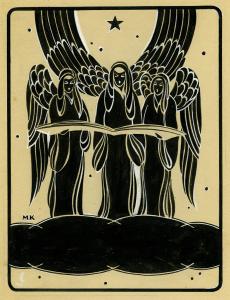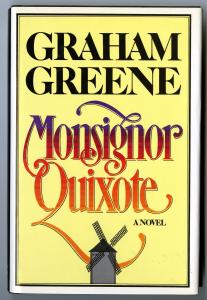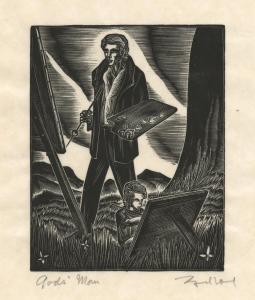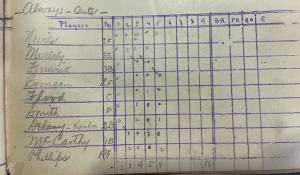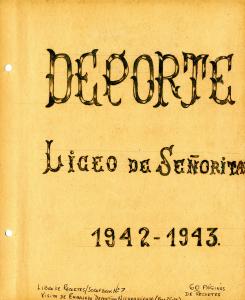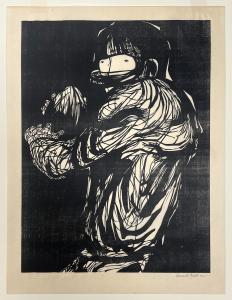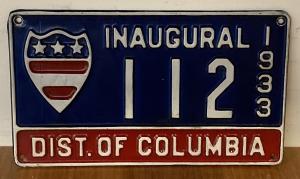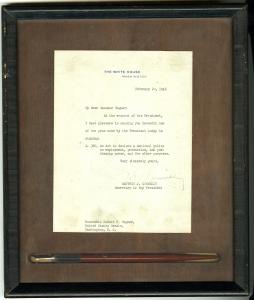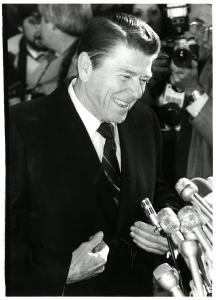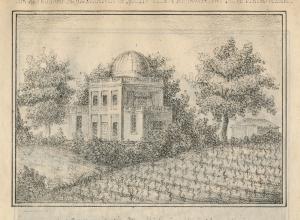This exhibition reveals the interrelated holdings in the Booth Family Center for Special Collections across all curatorial units including the University Archives, the Art Collection. Rare Books, Manuscripts and the Woodstock Theological Library. In so doing it presents a rare opportunity for viewers to see these items displayed together in imaginative pairings and groupings. Synergies Across Collections celebrates the richness of the Library’s non-circulating special collections and why they are such a valuable resource for students, faculty and researchers.
Working collaboratively, the Booth curators selected four themes that demonstrate the interconnectedness of its holdings. These include Authorship, Sports, Presidents and Elections, and Jesuits in Science. In the process of selecting and assembling these materials, the curators made discoveries they might not have been aware of within other units’ holdings, and are delighted to share them with our viewers for the first time. They have assembled seldom seen items that illuminate the same concepts and subject matter in uniquely different ways.
Among the items in the Authorship case are pioneering wordless artists’ books, manuscripts and books by English author Graham Greene, and a facsimile of the Tom Sawyer manuscript in Booth’s vault. There are also fascinating devices used in the creative process – some now obsolete – such as a manual typewriter, a lithographic stone, and a miniature etching press.
The items in the Sports section reveal how athletic events are documented in the University Archives and how they are reflected in the artworks and publications of their respective eras. Enthusiasts will delight in the range of ephemera such as NCAA commissioned soda bottles from the 1980s, a football from a 1928 NYU vs. GU game, and a crew racing jersey from the 1960s.
Chosen for its timeliness, the Presidents and Elections grouping features material about Abraham Lincoln and his successors up through Bill Clinton. The range includes archival photographs, inauguration memorabilia, a Black voting rights poster and a whimsical 1970s painting of feet seen below the curtain of a voting booth by Black artist Ernie Barnes.
Holdings of the Woodstock Theological Library are well represented in good company with the other Booth units in the display on Jesuits in Science. This section highlights astronomical observatories, early Jesuit missionaries in Asia, and geological studies. A 17th-century volume on the earth’s interior by the Jesuit polymath Athanasius Kircher is paired with a Pictorialist photograph from the Art Collection of Paricutin, the Mexican volcano in the center of a cornfield that erupted between 1943 and 1952.
Please refer to the Booth Web page if you would like to find out more about these materials or reach out to us at speccoll@georgetown.edu
Authorship
Untitled [Christmas design, three angels singing]
Marguerite Elizabeth Kumm
(American, 1902 – 1992)
20th century
Ink with gouache on illustration board
1992.2.661
This mid-century illustration of a trio of angels singing from a hymnal is a design for a Christmas card. The Minnesota born artist Marguerite Kumm studied art at the Corcoran in Washington, DC and had a career as an illustrator and designer for magazine articles and advertisements. Georgetown holds the largest institutional collection of Kumm’s work along with her personal papers.
Flier advertising a talk by Sophy Burnham promoting her book The Path of Prayer
2002
Sophy Burnham Papers
GTM-GAMMS129
A Book of Angels
Sophy Burnham
New York: Random House Audiobooks, 1994
Sophy Burnham Papers
GTM-GAMMS129
A Book of Angels
Sophy Burnham
New York: Jeremy P. Tarcher/Penguin, 2011
Sophy Burnham Papers
GTM-GAMMS129
Carmina Theologorum
Woodstock College Seminarians
1905
Woodstock College Archives
WTL-19761101
Jesuits have been interested in the arts since their founding. Featured is a collection of multilingual poetry written by Jesuit seminarians and faculty members at Woodstock College in celebration of the feast of the Assumption of the Blessed Virgin Mary.
Graham Greene: Friend and Brother
Leopoldo Duran
London: Harper Collins, 1994
Rare Books Collection
Page from a manuscript of Monsignor Quixote by Graham Greene
1981
Graham Greene Papers
GTM-851001
Monsignor Quixote
Greene, Graham
Toronto : Lester & Orpen Dennys, 1982
Rare Books Collection
Greene 1070
Lillie's Autograph Book
1850-1854
GTM-0052
Graham Greene’s Commonplace Book
1977
Leopoldo Duran Papers
GTM-110727
Commonplace Books
1851-1856
GTM-131213
Commonplace books are handwritten volumes filled with various quotes, notes, letters, poems, short stories, recipes, and drawings. They were especially popular from the 17th to 19th centuries. These examples include a book that belonged to a young woman from New England named Lillie, the English writer Graham Greene, and an anonymous 19th century author (likely from England).
A Kafka Alphabet
Joseph W. Reed (American, 1932 – 2019)
Undated
Etching on paper
1111.1.6264
Many of artist Joseph Reed’s etchings depict historical figures such as the First Ladies of the United States, authors, and performers. He was also fond of alphabetic designs. This unusual abecedary is inspired by Franz Kafka’s famous novela The Metamorphoses (1915). It is inscribed in pencil to the late Georgetown University Archivist Jon Reynolds, thanking him for sharing a “Jesuit Alphabet.” This may refer to the Latin-Chinese alphabet devised by Jesuit missionaries for representing the Japanese language in the late 16th century.
Style Book of The Hoya
Revised by John J. Cassidy
1951
Hoya File
GTA-000634
The first edition of this book was created in 1937 by Charles J. Cole for Hoya staffers and “heelers,” candidates for positions on the newspaper.
Concordance Omission
Bervin, Jen
New York, New York : Granary Books, 2023
Rare Books Collection
N7433.4.B47 C66 2023
“No” was left out of the A Concordance of the Poetry of Emily Dickinson, 1964, for being “nonsignificant” despite appearing 395 times. Bervin indexes all of Dickinson’s “no’s” in this artists’ book.
Blanche Neige : une imagerie d'après le conte
Lavater, Warja
Paris : Adrien Maeght Éditeur, 1974
Rare Books Collection
N7433.4.H66 B5 1974
Not all published books are written with words. In this abstract version of Snow White, Warja Lavater uses symbols and shapes to tell the story. Snow White is represented by a dot with a pink nucleus, the evil queen by an acid green dot with a black nucleus, the dwarves by red diamonds, the prince by a blue dot, and the apple by concentric circles of green, yellow and red around a black nucleus.
Gods' Man a Novel in Woodcuts
Lynd Ward (American, 1905 – 1985)
(New York: Cape and Smith, 1929)
Gift of Ingrid Rose in Memory of Milton M. Rose
2019.28.3
Untitled [man and child painting at easels, 132, for Ward’s ‘Gods’ Man’]
Lynd Ward (American, 1905 – 1985)
1929
Boxwood printing block
Gift of Robin Ward Savage and Nanda Weedon Ward, 1985
1985.2.298
Untitled [man and child painting at easels, 132, for Ward’s ‘Gods’ Man’]
Lynd Ward (American, 1905 – 1985)
1929
Wood engraving on paper
Gift of Robin Ward Savage and Nanda Weedon Ward, 1981
1981.1.967
Lynd Ward was a prolific and award-winning mid-century book illustrator best-known for his six wordless novels published between 1929 and 1937. The first was Gods’ Man, a faustian story about an artist who sells his soul to the devil. The Library owns all of the wood engraved blocks used in printing this ground-breaking work which inaugurated the genre of the graphic novel in the United States.
The Adventures of Tom Sawyer
Twain, Mark
Hartford, Conn. : American Pub. Co., 1876
Rare Books Collection
PS1306 .A1 1876b
The Adventures of Tom Sawyer in three unique formats: manuscript, facsimile, and published. The manuscript of Tom Sawyer is written and signed by Mark Twain and includes corrections and edits. The manuscript was donated by Genevieve Garvan Brady in 1934. The facsimile was created in 1983 to facilitate access to the manuscript while protecting and preserving the original. The published version of Tom Sawyer, in blue book cloth, is a first edition.
John Courtney Murray, S.J., Typewriter
1962-1965
Woodstock College Archives
WTL-19761101
John Courtney Murray, S.J., a twentieth-century theologian, used this typewriter while in Rome for one of the most important councils in Catholic Church history–Vatican II. His influence guided the council’s declaration on religious liberty known as Dignitatis Humane.
Remington Noiseless
Carol Wax
(American, b. 1953)
1986
Mezzotint on paper
Fairchild Endowment Fund purchase, 2011
2011.28.1
Fountain pen used by Graham Greene to write The Heart of the Matter
circa 1948
Graham Greene - Catherine Walston Collection
GTM-GAMMS168
Lithographic Stone - Principles of Geometry
Benedict Sestini, S.J.
1971
Woodstock College Archives
WTL-19761101
The Jesuits of Woodstock College had a traditional printing press for publishing their theological and scientific textbooks, but they also incorporated illustrations using lithography. This particular lithographic stone depicts geometric figures.
Permo Etching Press
Morris Henry Hobbs (American, 1892 – 1967), designer
ca. 1936
Gift of Reed Isbell in memory of William J. Hobbs, 2014
2014.42.53
The Permo Etching Press was designed by artist Morris Henry Hobbs and made in Chicago. This press was donated to Georgetown by the estate of the artist.
Sports
Untitled [Track meet announcement]
John E. Sheridan
(American, 1880 – 1948)
1900
Lithograph on paper
1111.1.6573
John Sheridan was a student at Georgetown College at the turn of the 20th century. A talented artist and designer, he contributed illustrations to Ye Domesday Booke as well as posters advertising college athletic events. This poster announces an indoor track meet at the Convention Hall, on Feb. 17, 1900 with a prototypical image of a youthful runner wearing a collegiate sweater.
Woodstock World Series Box Scores
1902
Woodstock College Archives
WTL-19761101
While studying for ordination, Woodstock College seminarians also enjoyed recreational activities like baseball. The games were competitive but also fun, showcased by team names such as “The Never Hits” and “The Always Outs.”
Woodstock Walking Club Scrapbook
1894-1908
Woodstock College Archives
WTL-19761101
The Woodstock Walking Club was an idyllic recreation for the seminarians of Woodstock. The scrapbook contains colorful posters advertising upcoming walks (including the flowers in bloom), and a songbook, with hymns dedicated to the glories of the club.
Georgetown College baseball scorebook, 1869-1873
Open to the game between the Quicksteps and the Stonewalls, October 26, 1869
Sports Files: Baseball, box 1
GTA-000241
Team sports did not emerge on campus until after the Civil War. By 1869 the College had two baseball clubs, the Stonewalls and the Quicksteps, who played on the field which we know as Copley Lawn. Georgetown played its first intercollegiate game against Columbian College (now George Washington University) in 1870.
Jack Dempsey vs. Argentine Heavyweight Luis Ángel Firpo
Diana Thorne
(American, 1895 – 1963)
ca. 1940
Etching with drypoint on paper
Art Collection purchase, 1995
1995.13.6
Dempsey was defending the World Heavyweight title he’d held since 1919. Firpo was the first Latin American boxer to challenge for the title.
Le magasin des écoliers : encyclopédie illustrée des récréations utiles et amusantes
Savigny, Laurence de.
Paris : Didier, 18??
Rare Books Collection
GV1201 .S26 1800z
En Garde! This schoolchildren’s collection of games, sports, and other recreational activities includes helpful instructions for learning how to fence.
British boxing : With 8 plates in colour and 27 illus. in black & white
Batchelor, Denzil
London : Collins, 1948
Rare Books Collection
GV1123 .B38 1948
Pugilistica : Being one hundred and forty-four years of the history of British boxing
Miles, Henry Downes
London: Weldon, 1880-1881
Rare Books Collection
GV1123 .M64
A collection of the greatest British boxers, with 100 wood engraved portraits of British champions.
Fencing foils and mask
date unknown
Athletic Memorabilia, Box 3
GTA-000759, box 3
Fencing lessons were first offered on campus in 1798 when two fencing masters, who also taught dancing, were hired. Stamps on the blade of these foils indicate they were made by Coulaux, a French company which operated from the early 1800s until 1962.
Presidential audience for NCAA Champion Hoyas
William Auth
April 7, 1984
Sports Photographs: Basketball, Box 3
Pictured left to right: Fred Brown; Coach John Thompson; President Ronald Reagan; Gene Smith; Ralph Dalton (at the back); manager George Jackson; and Reggie Williams
On April 2, 1984, the Georgetown basketball team won the NCAA Championship, beating Houston 84-75. April 7, 1984 was officially designated Georgetown Hoya Championship day in D.C. The day began with a Presidential audience in the Rose Garden, followed by a ceremony on the steps of the District Building during which Mayor Marion Barry presented Coach Thompson with the key to the city.
NCAA commemorative soda bottles
Coca-Cola Company, Philip Morris
1984
Georgetown Basketball Soda Bottles
GTA-000758
Basketball Game Between University of Miami and Georgetown
Flip Schulke
(American, b. 1930)
1960
Gelatin silver print [facsimile]
Gift of Jeffrey Perry, 2016
2016.2.19
1960
Gelatin silver contact sheet [facsimile]
Gift of Jeffrey Perry, 2017
2017.20.61
Deporte – Liceo de Señoritas scrapbook pages
1943-1943
Esther Neira de Calvo Papers
GTM-071217
Esther Neira de Calvo (1890-1978) was a Panamanian educator, politician, diplomat, and women's rights advocate. In 1938, she founded the Lyceum, a university preparatory school for women that she directed until 1945. This scrapbook documents a visit from a Nicaraguan sports delegation to the Lyceum in the early 1940s.
Football
Leonard Baskin
(American, 1922 – 2000)
1960
Woodcut on paper
Gift of Jay Finkel, 2014
2014.10.15
Leonard Baskin was a prolific woodcut artist, sculptor and illustrator. During his studies at Yale University in the 1940s he founded one of the earliest fine art presses which he named the Gehenna Press, inspired by a quote from Paradise Lost. This dynamic image of a football player was created when his career in Boston was gaining momentum following his first solo exhibition in 1956. The body of the athlete is rendered in energetic, fluid lines that vary in thickness to suggest the contours of the player’s football uniform.
Program and ticket from the Orange Bowl
1941
Sports File: Football, Box 1 / Sports Photographs: Football, Box 1
During the 1938, 1939 and 1940 seasons the Hoya football team compiled a remarkable record of 23-1-2. On January 1st, 1941, Georgetown faced Mississippi State in the Orange Bowl. Depleted by injuries, the Hoyas lost 14-7.
Football from NYU-GU game
November 3, 1928
Athletic Memorabilia, Box 3
GTA-000759
The game, won by Georgetown 7-2, was played at Yankee Stadium in front of 50,000 fans.
Georgetown sports-themed tobacco silk
Murad Cigarettes
ca. 1906
Gift of Eric Wind, F’2009
American tobacco companies began including promotional fabric swatches in their packaging between 1906 and 1910. Although these swatches were often made from satin, they became known as tobacco or cigarette “silks.” Companies encouraged women to make them into household items such as aprons or pillows—in fact, the inclusion of silks may have been a marketing strategy to encourage women to smoke.
Schweppes International Regatta
O’Brien
(American)
1992
Screenprint/serigraph on paper
Fairchild Endowment Fund purchase, 2012
2012.6.1
This poster promoting the third Schweppes International Regatta on the Potomac in April 1992, features a tranquil scene of rowers near Key Bridge. The spires and skyline of campus buildings may be seen in the distance. Sixteen colleges including Cambridge and Oxford from the U.K., and eight high schools competed in the regatta. According to accounts in The Hoya and the local papers, Cornell beat Cambridge to win the men’s varsity 8 race final. The Georgetown men’s team, which competed in the 9th through 11th seeds final, captured third place with a time of 5:44.22.
Men’s crew racing uniform shirt
Worn by team members from April 1961-Spring 1966
Gift of Ed Witman, C’1967
Crew Alumni Collection
GTA-150429
Presidents & Elections
The federalist: a collection of essays, written in favour of the new Constitution, as agreed upon by the Federal convention, September 17, 1787, in two volumes.
Essays written by Alexander Hamilton, James Madison and John Jay.
New-York : Printed and sold by J. and A. M'Lean, 1788
Rare Books Collection
JK154 1788
A series of 85 essays, the Federalist Papers were written by Alexander Hamilton, James Madison, and John Jay to encourage New York citizens to support the Constitution. The essays were originally published in The New York Packet and The Independent Journal. This collected bound edition was printed by J. and A. McLean and includes revisions and corrections by Hamilton.
Order of payment to Abram Eddins signed by James Madison
1814
Presidential Autographs Collection
GTM-140212
Political debates between Hon. Abraham Lincoln and Hon. Stephen A. Douglas, in the celebrated campaign of 1858, in Illinois; including the preceding speeches of each, at Chicago, Springfield, etc;
Lincoln, Abraham and Stephen A. Douglas
Columbus, Follett, Foster and Co., 1860
Rare Books Collection
90A73
Illinois Senatorial Candidates Abraham Lincoln and Stephen A. Douglas engaged in a series of seven debates leading up to the 1858 election. Lincoln used the text of both candidates' speeches to publish a text of Lincoln-Douglas debates. The success of the publication helped Lincoln to earn the 1860 Republican party Presidential nomination.
Inauguration of Abraham Lincoln as President of the United States: At the Capitol, Washington, March 4, 1861 (from a drawing made on the spot)
from Harper’s Weekly
Winslow Homer
(American, 1836 – 1910), copy after
March 16, 1861
Wood engraving with hand coloring on paper
Gift of Jeanette Studley and Wesley Pickard, 2005
2005.9.5
The inauguration of Abraham Lincoln took place on the east front of the Capitol, whereas contemporary inaugurations happen on the west front. The president elect was heavily guarded due to death threats from southern secessionists. The dignitaries on the platform that day included Lincoln’s political adversaries Senator Stephen A. Douglas, outgoing President James Buchanan, and Chief Justice Roger Taney, who administered the oath of office.
Discharge notice for Edward F. Blair, prisoner of war at Camp Chase, signed by Abraham Lincoln
1863
Presidential Autographs Collection
GTM-140212
Inaugural 112, 1933, Dist. of Columbia license plates
From the inauguration of President Franklin D. Roosevelt and Vice President John N. Garner, March 4th, 1933
U.S. Presidents Inaugural Ephemera, Box 1
GTA-GAMMS256
As was customary, the President of Georgetown (in 1933 that was Father W. Coleman Nevils, S.J.) was a member of the Distinguished Visitors’ Committee for the first inauguration of Franklin D. Roosevelt.
Woodstock Diary entry for 1936 Election
1936
Woodstock College Archives
WTL-19761101
Jesuits were hotly divided on the run up to the 1936 presidential election. This House Diary for Woodstock College reports the sentiment of the Jesuit community as they awaited the results.
Letter from Matthew J. Connelly, Secretary to the President, to Robert F. Wagner, with a pen used by Harry S. Truman to sign the Employment Act of 1946 into law
1946
Robert F. Wagner Papers
GTM-491023
Maggie Truman Campaigning, New York City
Leonard Freed
(American, 1929 – 2006)
1954 – 1955
Gelatin silver print
Gift of Jeffrey Perry, 2016
2016.1.14
Although Maggie Truman often campaigned with her father Harry Truman during his presidency, in this photo she is shown campaigning for W. Averell Harriman, who ran successfully for Governor of New York.
Ticket to and photographs of Inaugural Ball held in McDonough Gym
1953
U.S. Presidents Inaugural Ephemera, Box 1
GTA-GAMMS256
On January 20, 1953, two inaugural balls were held for President Dwight D. Eisenhower and Vice President Richard Nixon. One was held at the D.C. Armory on East Capitol Street, S.E., the other on Georgetown’s campus in McDonough Gymnasium.
Al Smith and his America
Handlin, Oscar
Boston, Massachusetts : Little, Brown, 1958
Rare Books Collection
78A224
Al Smith served four terms as the Governor of New York and was the first Roman Catholic Presidential candidate nominated by a major party. Smith was the 1928 Democratic nominee but lost the election to Hebert Hoover in a landslide defeat.
Photograph of the scene outside the White House shortly after President Kennedy was assassinated
1963
Gene Basset Collection of Political Photographs
GTM-770301
Father John F. Devine, S.J., Director of the Student Personnel Office, leads mass in the Quadrangle after news of President John F. Kennedy’s death reached campus
November 22, 1963
University Archives Photographic Collection (Oversize)
Friday, November 22, 1963, began with students anticipating a football game the next day against Frostburg State. This game was especially meaningful as it was to mark a return to intercollegiate play for the Hoyas after football had been eliminated as a varsity sport in 1951. The game and all other weekend activities were canceled, as were classes the following Monday for the President’s funeral.
Hands That Pick Cotton… Now Can Pick Our Public Officials
H. Kofi Bailey
(American, 1931 – 1981), artist
Voter Education Project
(American, 1962 – 1992), sponsor
1970
Commercial/offset printing on paper
Gift of Stephanie Hughes, 2023
2023.26.1
Artist Kofi Bailey, a committed civil rights activist, was commissioned to create this poster by the Voter Education Project (VEP), which at the time was headed by Congressman and former SNCC Chairman John Lewis. The VEP added almost 4 million minority voters to the rolls under Lewis’s directorship.
Voting Booth
Ernie Barnes
(American, 1938 – 2009)
ca. 1975
Oil on canvas
1111.1.1045
Ernie Barnes was born in Durham, North Carolina, and attended the North Carolina Central University on a full athletic scholarship. For six years he played professional football with the Baltimore Colts, the San Diego Chargers, and the Denver Broncos until a broken ankle ended his career. He then devoted his energies to art, and in 1966 he had his first New York exhibition at the Grand Central Art Gallery. Barnes is known for paintings of athletes as well as genre scenes like this whimsical view of feet beneath the curtain at a voting booth.
Carter : the will to win
Godden, Jean H
Cincinnati, Ohio : Mosaic Press, 1980
Rare Books Collection
E873 .G6 1980
Photograph of Ronald Reagan
circa 1980
Gene Basset Collection of Political Photographs
GTM-770301
Reagan : the man from Main Street USA
Trimble, Vance H.
Cincinnati, Ohio : Mosaic Press, 1980
Rare Books Collection
E877 .T75 1980
Miniature biographies of President Jimmy Carter and President Ronald Regan.
Election '84 roundup : the communist view : speech by Gus Hall, Communist candidate for president, General Secretary, C.P.U.S.A., at New York City forum, Unity Center, Friday, November 16, 1984
Hall, Gus
New York, N.Y. : Communist Party USA
Rare Books Collection
06A919
Text of Presidential Candidate Gus Hall’s speech on the 1984 United States Presidential Election. Hall discusses the election of Ronald Reagan and examines how the Communist Party fared in the election.
Various Political Campaign Buttons, Ronald Reagan belt buckle, and souvenir pocket knife
Unknown (Unknown)
1960 – 1999
Gift of Kenneth G. Robinson
2006.7.1
President-elect Bill Clinton addresses the Diplomatic Corps from the steps of Old North
Mike Milkovitch
January 18, 1993
Photographs: U.S. Presidents and their Families at Georgetown
GTA000121
Bill Clinton launched his bid for the presidency on October 3, 1991, in Little Rock, Arkansas. President-elect Clinton visited campus in January 1993 as part of his pre-inaugural activities.
“Personalities in the News”
Courier [Foreign Service School newsletter]
December 1964
Bill Clinton (F’1968) is pictured to the right in the fall of his freshman year. The opposite page includes a photograph of Gloria Macapagal, later Gloria Macapagal-Arroyo, who like Clinton would become a head of state. She served as the 14th President of the Philippines from 2001 until 2010.
Jesuits & Science
Almagestum Novum
Giovanni Riccioli
Bononiae: Haeredis Victorij Benatij, 1651
Woodstock Theological Library Collection
Vault QB41.R4 1651
Giovanni Riccioli, S.J., beautifully illustrates this work of astronomy with a highly symbolic frontispiece that depicts the weighing of the Copernicus’ heliocentric model and Tycho Brahe’s geocentric model on the scale of truth.
Description De L’Ancienne Jerusalem Selon Villalpand
Juan Bautista Villalpando
(Spanish, 1552 – 1608)
1722
Engraving on paper
Gift of Deena Barlev in memory of her father, Samuel Halperin, 2015
2015.14.35
This imaginary map of ancient Jerusalem relies on the work of architect and Jesuit Villalpando, who interpreted the writings of Hebrew prophet Ezekiel to visually reconstruct buildings in the Bible. The Spanish Inquisition investigated his work as possibly heretical misinterpretations of scripture; he was subsequently found innocent.
Le soleil. Exposé des principales découvertes modernes sur la structure de cet astre, son influence dans l'univers et ses relations avec les autres corps célestes
Secchi, Angelo
Paris, Gauthier-Villars, 1870
Rare Books Collection
QB521 .S44 1870
As an early astrophysicist, Secchi was the first to apply spectroscopy to the study of stars, creating the field of astronomical spectroscopy. In this work, Secchi examines the elemental makeup of the Sun and classifies it as a star. The chromolithograph illustrates the spectroscopic analysis of the Sun.
Christophorus Clavius
Edme de Boulonois
(Flemish, active ca. 1682)
Académie des Sciences et des Arts, Contenant les Vies, & les Eloges Historiques des Hommes Illustres. Isaac Bullart. Amsterdam: Elzevier, 1682
Engraving on paper
Gift of James C. and Mary G. Holland, 2010
2010.20.247
Clavius (German, 1538 – 1612) worked successfully for the adoption of rigorous mathematical curricula in Jesuit colleges, at a time when the importance of mathematics was widely underappreciated.
Gnomonices libri octo, in quibus non solum horologiorum solariu[m]...
Christophorus Clavius, S.J.
Rome: Franciscum Zanettum, 1681
Woodstock Theological Library Collection
Cube QB215 .C57 1581
This work by Cristoph Clavius, S.J., demonstrates the geometrical theory behind the use and construction of sundials.
El Parícutin, Michoacán, Mexico
Hugo Brehme
(German, 1882 – 1954)
20th century
Gelatin silver print [facsimile]
Gift of Jeffrey Perry, 2010
2010.3.21
The Parícutin volcano appeared suddenly in 1943, and was active for nine years. Its eruption gave scientists their first opportunity to document the full life cycle of a volcano using modern scientific methods.
Mundus Subterraneus
Athanasius Kircher, S.J.
Amsterdam: Joannem Janssonium, 1665
Woodstock Theological Library
Vault Folios ; Q155 .K6 1665
A noted polymath, Athanasius Kircher, S.J., was a key figure in the history of early modern science. His curiosity was legendary, and he once had himself lowered into an active volcano. Mundus Subterraneus develops his theories on the interior of the earth from his own observations.
Untitled [Matthew Ricci & L. Paul]
Wenceslaus Hollar
(Bohemian, 1607 – 1677)
17th century
Etching on paper
1989.9.5
Jesuit scholar Matteo Ricci (1552-1610) was one of the founding Jesuit missionaries in China. He began his work in the Portuguese settlement of Macau in 1582, where some of the Chinese people had converted to Christianity. There he became one of the first Europeans to master classical Chinese (spoken and written) and became known for his knowledge of mathematics, cartography and astronomy. As a result of these attainments he was invited to the Imperial Court at the Forbidden City 1601. A year later he published an influential world map known as the Kunyu Wanguo.
This etching depicting Ricci at left with Xu Guangqi, a Catholic convert known as Paul Hsü, was published in Athanasius Kircher's China Illustrata in 1667. Hsü studied with Ricci and helped translate Western volumes on mathematics, hydraulics, and geography into Chinese. Their translation of Euclid’s Elements was highly influential on Chinese mathematics.
Woodstock College Observatory
1894
Woodstock College Archives Photograph Collection
WTL-0010
The observatory at Woodstock College was constructed by Fr. John T. Hedrick (1853-1923) near the school’s greenhouse in 1889. Previous faculty had been making daily weather observations for the US Weather Bureau since 1870.
Bernard Doucette, SJ
ca. 1940
Woodstock College Archives Photograph Collection
WTL-0010
Fr. Bernard Doucette (1895-1974) utilizing the telescope at the Padre Faura St. observatory in Manila. He was the Chief of the Meteorological Division there beginning in 1933.
First chart and catalogue for observing Nova Persei
Georgetown College Observatory
Washington, D.C. : Georgetown University Press, 1901
Rare Books Collection
QB841 .G34 1901
Built in 1844 under the direction of Fr. James Curley, the Georgetown College Observatory observed the night sky until it closed in 1971. This chart records observations of the 1901 Nova Persei, which was the brightest nova event observed at the time.
Astronomical Building
ca. 1930
Woodstock College Archives Photograph Collection
WTL-0010
Two views of the Manila Observatory astronomical building on Padre Faura St. The telescope had received a new shutter system in the early 1930s. The structure was one of those destroyed by bombing in 1945.
Manila Observatory Grounds
ca. 1900
Woodstock College Archives Photograph Collection
WTL-0010
Two views of the Padre Faura St. observatory grounds in Manila. After the grounds were destroyed during World War II, a new observatory was constructed in 1951 at Mirador, Baguio.
Chart and catalogue for observing Nova Geminorum
Georgetown College Observatory
Washington, D.C. : Georgetown University Press, 1903
Rare Books Collection
QB4 .G35 1903
This 1903 chart records observations of a nova star, Nova Geminorum, in the Gemini constellation.
The Astronomical Observatory of Jesuits College at Georgetown D.C.
Unknown (American)
1844-1854
Lithograph on paper
1111.1.6606
Annals of the Astronomical Observatory of Georgetown College, D.C. No. I
Edward Dunigan & Brother: New York, 1852
GTA-000461
Proposed by Fr. James Curley, S.J., the Observatory was built between 1843 and 1844. One of the first fixed astronomical observatories in the U.S., it was used for teaching and research until the University’s Astronomy Department closed in 1971.
Observations on Solar Spots, Made at the Observatory of Georgetown College, Sep. 20, to Nov. 6, 1850
Benedict J. Sestini, S.J.
Washington : C. Alexander, printer, 1853
Observatory Files
GTA-000193
In September, October and November 1850, Fr. Sestini conducted a series of observations of sunspots. When these were published in 1853, they were immediately recognized as an authoritative study of the subject.
Benedict Sestini, S.J.
Henry McLoughlin
1890
University Archives Photographic Collection
GTA-000109
Father Sestini was born in Italy in 1816. An astronomer and mathematician, he came to Georgetown in 1848 and became assistant director of the fledgling Georgetown Observatory. He also taught mathematics at Georgetown College, Woodstock College, and Boston College.
Seismographs on campus
circa 1911
University Archives Photographic Collection
GTA-000109
Georgetown’s Seismological Observatory was founded in 1910 by Francis A. Tondorf, S.J. Equipped with a horizontal and a vertical Wiechert seismograph, it was the most complete station of its kind in the U.S. The seismographs were first housed at the base of Healy Hall’s south tower. But, after it became apparent that the sway of the 212 foot tower in the wind would impact readings, the instruments were moved to a subterranean vault under the Quadrangle.
La météorologie et le météorographe à l'Exposition universelle
Secchi, Angelo
Paris, Gauthier-Villars, 1867
Rare Books Collection
QC876 .S44 1867
In addition to being an astronomer, Angelo Secchi, S.J. was a meteorologist and inventor. This catalog contains meteorological tools displayed at the 1867 Exposition Universelle in Paris, France. Secchi brought an instrument he developed himself, although it did not work according to his design.
Francis A. Todorf, S.J.
ca. 1929
University Archives Photographic Collection
GTA-000109
A succession of Jesuits directed the work of the Seismological Observatory. After the first director Father Tondorf died in 1929 he was succeeded by Father Frederick W. Sohon. Later Father Edward Powers, followed by Father Francis Heyden, assumed responsibility for the instruments.
Seismological Despatches, Georgetown University
November 1940
Seismological Observatory Files
GTA-000365
The Seismological Despatches were compiled excerpts from earthquake reports received at Georgetown. The November 1940 issue mentions what would become known as the Vrancea or Bucharest earthquake, which occurred on November 10. At a magnitude of 7.7, it was the strongest earthquake recorded in twentieth-century Romania. Its effects were felt as far north as Leningrad and as far south as Greece.
Record of his Hot House
James Curley, SJ
1870-1899
James Curley, SJ Papers
GTM-GAMMS42
The journal of the Georgetown College greenhouse and garden, written by Fr. James Curley (1796-1889), including sketches and illustrations of various flora. He was instrumental in establishing the school’s greenhouse and observatory in the 1840s.
Woodstock Weather Bureau Reports
1915-1918
Woodstock College Archives
WTL-19761101
In addition to their training for ordination, the Jesuit seminarians at Woodstock College were also active in scientific research. For decades they collected and submitted daily weather reports for the U.S. Weather Bureau.
Curators: Lynn Conway, Aleksandra Kinlen, Christen Runge, Jay Sylvestre, Adrian Vaagenes, LuLen Walker and John Zarrillo
Exhibition Web Page: Emily Jeong (SFS '2025)

